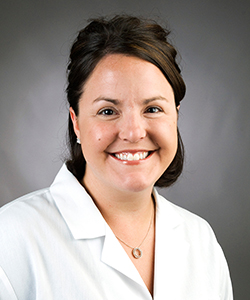By: Courtney Barnes, MD
The Answer Isn’t Black and White
September 11, 2020

Let me start by saying I’ve been an obstetrician for 15 years, which translates into having cared for thousands of pregnant women and their babies. The medical side of how I treat patients is ever changing. Each week brings new research, updated protocols and refined treatment guidelines.

One part of this job, however, has stayed the same — the emotion felt when a newborn infant is placed into the arms of her mother for the very first time. Even after all these years of practice, this moment can still bring tears to my eyes. This part of birth always reminds me that the decision to go into obstetrics wasn’t a difficult one — it was the only one.
Like most, I am not the same doctor today as I was when I started this journey. With each passing year, I become a better listener. Supporting a family as it works toward a healthy pregnancy, birth and recovery encompasses so much more than just checking the fetal heartbeat, translating ultrasound reports and doing prenatal labs. It is encouraging mothers to trust themselves. It is showing them the strength and power that motherhood grants. It is empowering women toward body autonomy and shared decision-making.
Each mother carries her own health history, unique beliefs, distinct values and her own support system. My job is to look at all these variables and calculate the risk of pregnancy for both mom and baby. One of the variables that has an impact on pregnancy outcomes is race. How does race impact risk?
Same Playing Field, Different Outcomes
In the United States, if a Black woman and a white woman with the same exact physical characteristics (weight, height, blood pressure, etc.) receive the same prenatal care, the Black woman is likely to have a worse outcome than the white woman. Black women are more likely to have small babies, early babies, pre-eclampsia and high blood pressure. What’s more alarming, Black women are about four times more likely than white women to die in pregnancy, and their babies are two to three times more likely than white babies to die within the first year.
With race being the only obvious difference, some may look for other factors: diet, exercise, education or socioeconomic status. When I hear these factors being brought into the conversation, I know the focus is all wrong. When the statisticians look at all these variables and do their math to account for the confounding factors, the outcome differences remain.
So if it isn’t diet or exercise or education or money, what is it? To better explain, I’m going to get a little “science-y” on you. Hang in there with me because this is some really cool stuff.
Remember learning about genes in high school biology? Think of genes as the blueprint needed to build a human. Half of the blueprint comes from the egg (mom) and half from the sperm (dad). Most folks think of their DNA like a book where you read from front to back and follow the directions. Page 1: You have green eyes. Page 2: You are 5 feet tall. You get the idea. DNA isn’t a book, though. It’s more like a really, really long banner. In fact, if you stretched out the DNA of just one cell, the DNA would be about 6 feet long. To pack all that DNA into one teeny, tiny cell, there has to be some creative folding. When it comes time to do the building, the whole DNA doesn’t unfold, just the section that needs reading.
So the DNA itself is what you inherit from your parents. That part is relatively straightforward. You either get brown eyes or blue eyes. How it gets folded and crammed into the cell — well, that part can change. So let’s say that the long banner of your DNA is folded in such a way that the gene that codes for tumor suppression can be read, you remain cancer free. Alternatively, if the banner of your DNA is folded such that the tumor suppression code is hidden from view, you develop cancer.
The science term for this phenomenon is epigenetics.
The Connection between Epigenetics and Racism
Environmental factors can cause epigenetic changes: think things such as obesity, diet, smoking and chronic stress. Psychological stress, like experiencing violence or emotional abuse, can also change what part of the DNA gets read. Things like getting repeatedly pulled over in your own neighborhood because you don’t look like you belong, consistently getting in trouble at school for aggression when simply expressing your opinion, being chosen for additional screening nearly every time you fly — they all can cause stress that can lead to epigenetic changes.
This is how racism silently kills.
Here is another crazy thing: Research shows these epigenetic changes can be passed down from generation to generation. That means that the extraordinary stress of prolonged and traumatic events such as slavery and the holocaust can continue to affect the health of current generations.
So, the next question to ask is: Are the epigenetic changes permanent? Thankfully, research shows these changes are reversible, but it can take multiple generations.
Back to Pregnancy and Women's Health
Pregnancy presents a unique chance to discuss overall health, provide education, give emotional support and potentially impact epigenetic stressors. During a routine pregnancy, I talk about nutrition, physical activity, stress reduction, the health of relationships, communication, safety, etc. It hasn’t been until very recently; however, that I ask about racism, micro-aggressions and a history of distant trauma as it relates to the risk of developing future chronic diseases.
Any woman who has been pregnant will tell you that the physical demands of creating life are significant. The stress of pregnancy itself can also uncover a mother's predisposition for developing certain diseases in the future. Women with diabetes in pregnancy (gestational diabetes) are more likely to develop diabetes. Women with preterm deliveries and small babies are more likely to develop heart disease. Women with pre-eclampsia are more likely to develop high blood pressure.
Prenatal care, pregnancy and parenthood, when managed well, have the ability to change the trajectory of not only the mother’s health, but also that of her child, her family and of generations to come.
Where do we go from here?
While it is critical to break down the systems fueling racism, this is a problem that cannot be addressed solely within the health care setting. And the more we learn about systems, biases, racism, micro-aggressions and epigenetics, the crisis facing Black women almost feels too overwhelming to address. Where do we even start?
This is where I get to share some really great news. We already know some of the things that work for mothers. One program shown to reduce disparities between Black and white women in pregnancy is CenteringPregnancy, which MU Health Care implemented two years ago. CenteringPregnancy is group prenatal care. Rather than attending prenatal visits one-on-one, a group of eight to 12 women go through pregnancy together. This type of care has been shown to lower the risk of preterm birth, low-birth-weight infants and postpartum depression. CenteringPregnancy has also been shown to improve breastfeeding outcomes.
Because the groups meet over 10 sessions, lasting about two hours each, patients have more interaction with their provider. Women have time to build trust, ask questions and get the support they need to thrive. Women in Centering also develop relationships with other pregnant women. This peer support, along with 20 hours of education, results in improved communication, patient empowerment and tremendous emotional support. Group prenatal care is built around setting goals and practicing self-care. Women feel empowered and encouraged throughout their pregnancies. And, as it turns out, this is pretty darn good for improving outcomes.
Another program shown to reduce disparities between Black and white mothers is the Baby-Friendly Hospital Initiative. This is a program created by the World Health Organization that certifies hospitals following a specific set of infant feeding guidelines. Through a 10-step program, Baby-Friendly hospitals implement practices that aim to provide better education and support around infant feeding.
Baby-Friendly hospitals train all of their staff to better assist moms with breastfeeding. Protocols are in place to encourage mother-baby bonding right away. Research shows that it works. In one study observing 33 hospitals over the course of 31 months, Baby-Friendly initiatives were shown to improve breastfeeding initiation rates in all races from 66 to 75%, with Black mothers’ rates increasing from 46 to 63%.
Final Thoughts
It can be easy to move through our days, see these complicated problems and dismiss the issues as beyond our control. It is hard work to completely change the way we care for pregnant women. It takes humility to ask if there is a better way to do something. It is uncomfortable to look into the eyes of our patients and do more listening than talking. It takes vulnerability to admit that maybe the answers to these complicated problems lie within the patients and not within ourselves.
CenteringPregnancy and the Baby-Friendly Hospital Initiative have both been shown to reduce the disparities we see among Black women. These two programs have several things in common. They both seek to educate mothers — putting the science and the information in the patients’ hands. They both empower women to make decisions regarding their bodies, their health care and their choices. They both offer tremendous support as women are deciding what serves their family best.
Being a part of birth as a career is a pretty cool way to spend my days. The act of bringing life into the world can be transformative. A birth that supports and empowers can heal trauma. Care and understanding can reverse epigenetic changes passed through generations. The power to heal one another with love, listening and support is within all of us. What if, just maybe, the solution to this complicated problem, is just that simple?
Next Steps and Useful Resources
- Meet Courtney Barnes, MD Obstetrician.
- Interested in learning more about Centering?
- What does Baby-Friendly Mean? Dr. Barnes explains

